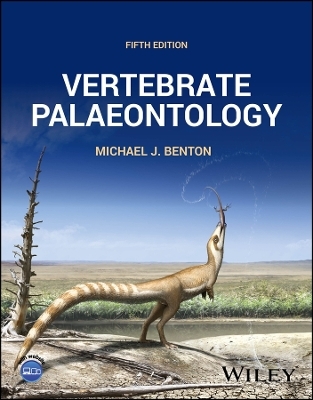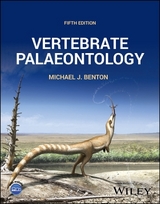Richly illustrated with cladograms of all major vertebrate taxa, Vertebrate Palaeontology provides a complete account of the evolution of vertebrates, including macroevolutionary trends and drivers that have shaped their organs and body plans, key transitions such as terrestrialization, endothermy, flight and impacts of mass extinctions on biodiversity and ecological drivers behind the origin of chordates and vertebrates, their limbs, jaws, feathers, and hairs.
This revised and updated Fifth Edition features numerous recent examples of breakthrough discoveries in line with the current macroevolutionary approach in palaeontology research, such as the evolutionary drivers that have shaped vertebrate development. Didactical features have been enhanced and include new functional and developmental feature spreads, key questions, and extensive references to useful websites.
Written by a leading academic in the field, Vertebrate Palaeontology discusses topics such as:
- Early palaeozoic fishes, covering cambrian vertebrates, placoderms (‘armour-plated monsters’), pan-chondrichthyes such as sharks and rays, and osteichthyes (‘bony fishes’)
- The first tetrapods, covering problems of life on land, diversity of carboniferous tetrapods and temnospondyls and reptiliomorphs following the carboniferous
- Mesozoic reptiles, covering testudinata (turtles), crocodylomorpha, pterosauria, great sea dragons and lepidosauria (lizards and snakes)
- Mammals of the northern hemisphere, covering scrotifera (bats and relatives), cetartiodactyla (cattle, pigs and whales) and zoomata (horses, carnivores and pangolins)
Michael J. Benton, FRS, is Professor of Vertebrate Palaeontology at the University of Bristol. He is particularly interested in early reptiles, Triassic dinosaurs and macroevolution, and has published over 50 books and 300 scientific articles. He leads one of the most active palaeontology research groups at the University of Bristol and has supervised more than 60 PhD students.
1 Vertebrates Originate 1.1 Sea squirts and the lancelet 1.2 Ambulacraria: echinoderms and hemichordates 1.3 Deuterostome relationships 1.4 Chordate origins 1.5 Vertebrates origins: worm or bag?
2 How to Study Fossil Vertebrates 2.1 Digging up bones 2.2 Publication and professionalism 2.3 Geology and fossil vertebrates 2.4 Biology and fossil vertebrates 2.5 Discovering phylogeny 2.6 Macroevolution
3 Early Palaeozoic Fishes 3.1 Cambrian vertebrates 3.2 Vertebrate hard tissues 3.3 The jawless fishes 3.4 Origin of jaws 3.5 Placoderms: armour-plated monsters 3.6 Pan-Chondrichthyes: sharks, rays, acanthodians 3.7 Early fish biogeography and environments 3.8 Osteichthyes: the bony fishes 3.9 Early fish evolution and mass extinction
4 The First Tetrapods 4.1 Problems of life on land 4.2 Devonian tetrapods 4.3 The Carboniferous world 4.4 Diversity of Carboniferous tetrapods 4.5 Temnospondyls and reptiliomorphs after the Carboniferous 4.6 E volution of the modern amphibians
5 Evolution of Early Amniotes 5.1 Hylonomus and Paleothyris -- biology of the first amniotes 5.2 Amniote adaptations for terrestrial life 5.3 The Permian world 5.4 The parareptiles 5.5 The eureptiles 5.6 Early synapsid evolution 5.7 The Permian-Triassic mass extinction
6 The Triassic Revolution 6.1 The Triassic world and the recovery of life 6.2 Triassic marine reptiles 6.3 E volution of the archosauromorphs 6.4 Origin of the dinosaurs 6.5 Amniote evolution in the Triassic
7 Evolution of Fishes after the Devonian 7.1 The early chimaeras and sharks 7.2 Post-Palaeozoic chondrichthyan radiation 7.3 The early bony fishes 7.4 Radiation of the teleosts 7.5 Post-Devonian evolution of fishes
8 Dinosaurs 8.1 Biology of Plateosaurus 8.2 The Jurassic and Cretaceous world 8.3 Saurischians and theropod diversity 8.4 The sauropodomorph dinosaurs 8.5 The diversity of ornithischian dinosaurs 8.6 Were the dinosaurs warm-blooded or not?
9 The Mesosoic Reptiles 9.1 Testudinata: the turtles 9.2 Crocodylomorpha 9.3 Pterosauria 9.4 The great sea dragons 9.5 Lepidosauria: lizards and snakes 9.6 The end-Cretaceous mass extinction
10 The Birds 10.1 The origin of birds 10.2 The origin of bird flight 10.3 Cretaceous birds, with and without teeth 10.4 The radiation of modern birds: explosion or long fuse? 10.5 Flightless birds: palaeognathae 10.6 Neognathae 10.7 The three-phase diversification of birds
11 Mammals: Origins and Southern Hemisphere Evolution 11.1 Cynodonts and the acquisition of mammaliaform characters 11.2 The first mammaliaforms 11.3 The Mesozoic mammaliaforms 11.4 Marsupials down under 11.5 South American mammals -- a world apart 11.6 Afrotheria and the break-up of Gondwana
12 Mammals of the Northern Hemisphere 12.1 Evolution of modern mammals 12.2 Boreoeutherian beginnings: the Palaeocene in the northern hemisphere 12.3 Early diverging laurasiatherians: eulipotyphla 12.4 Scrotifera: bats and relatives 12.5 Cetartiodactyla: cattle, pigs and whales 12.6 Zoomata: horses, carnivores and pangolins 12.7 Glires: rodents, rabbits and relatives 12.8 Archonta: primates, tree shrews and flying lemurs 12.9 Ice age extinction of large mammals
13 Human Evolution 13.1 What are the primates? 13.2 The fossil record of early primates 13.3 Anthropoidea: monkeys and apes 13.4 Hominoidea: the apes 13.5 E volution of human characteristics 13.6 The early stages of human evolution 13.7 The past two million years of human evolution
Appendix Classification of the vertebrates Glossary Index
| Erscheinungsdatum | 22.08.2024 |
|---|---|
| Verlagsort | New York |
| Sprache | englisch |
| Gewicht | 1837 g |
| Einbandart | kartoniert |
| Themenwelt | Sachbuch/Ratgeber ► Natur / Technik ► Natur / Ökologie |
| Geisteswissenschaften ► Archäologie | |
| Naturwissenschaften ► Geowissenschaften ► Mineralogie / Paläontologie | |
| ISBN-10 | 1-394-19508-7 / 1394195087 |
| ISBN-13 | 978-1-394-19508-4 / 9781394195084 |
| Zustand | Neuware |
| Informationen gemäß Produktsicherheitsverordnung (GPSR) | |
| Haben Sie eine Frage zum Produkt? |
aus dem Bereich





